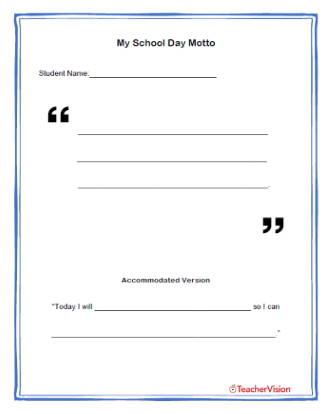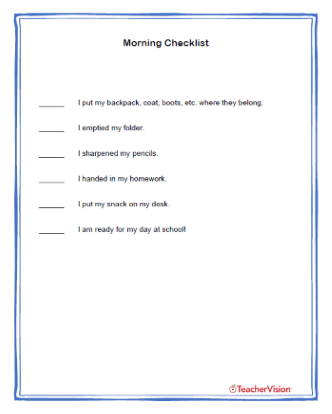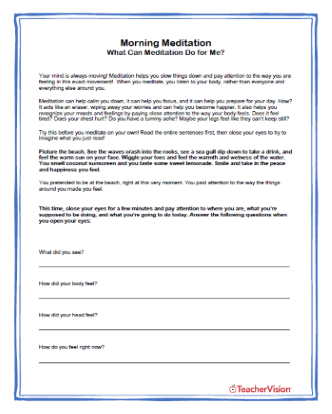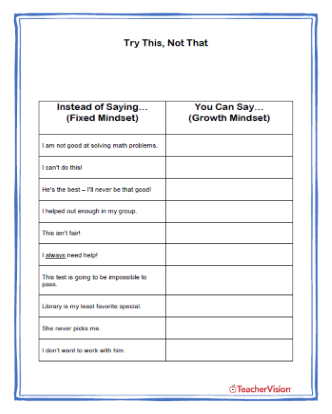The strategies in this playlist represent different activities and strategies that you can add into your existing daily routine and procedures. Each strategy is designed to provide students with an opportunity to set goals, take initiative, be mindful of their actions, and establish a growth mindset.
Strategy Name: My School Day Motto |
|
| A motto that matters to each student! | |
|
|
What Is It?A short motto that students can say to begin their school day or subject area, if they are at the grade level where they switch classes. It is made up by the students themself, rather than the teacher of the class. Why Is It Important?Each student is motivated by different factors. Some need a little jumpstart or a reboot before beginning the day or starting a class. Because students create the motto by themself, it is personally meaningful to them, their own expectations, and personal goals in a subject area. How Can You Make It Happen?You can model a personal motto that you come up with and can abide by yourself. You can explain why you selected it and how it helps you focus before you teach. For example, a sample motto for a teacher can be, “Be patient, be kind, be compassionate to all students’ needs.” When Can You Use It?The motto should be used at the beginning of each class. For example, before beginning instruction you can direct the class to take a moment and silently recite their motto to themselves. You can also remind students who are not being attentive, respectful, or dependable to think of their personal class motto and recall it. How Can You Manage It?A personal motto is simple to manage. Students can record it on a sheet which can be laminated and taped to their desk, hung around the room, or posted on or in their folder. Mottos may also be revised on a quarterly basis because students’ needs and goals may change, as may their external circumstances at home. A quarterly refresher is a great idea in order for them to come up with a new motto to get them going at the start of class. How Can You Stretch Students’ Thinking?It may be difficult at first for students to come up with a motto that actually means something to them. Through modeling and discussion, you can make a class list of goals, expectations, and responsibilities that they take on in school each day in order to generate ideas, which in return will help students create a motto. How Can You Modify And Support Students?You can set up prompts for students who need support and allow them to choose a prompt and fill in the blank with a word that resonates with them. |
Strategy Name: Morning Checklist |
|
| A helpful checklist that starts the day off right! | |
|
|
What Is It?Morning Checklist is designed to help students begin their day in an organized way. It is a small checklist that has visual and/or written prompts that remind students of the steps they should be taking as they enter the classroom without having to be told. Why Is It Important?Students need to learn to take it upon themselves to put away supplies, set up their desk, sharpen pencils, hand in homework, and set up their daily planners. They learn to rely on themselves rather than a teacher to guide them through the process every day. It teaches responsibility and independence. How Can You Make It Happen?Place a checklist on the edge of each student’s desk. The checklist should include no more than five things that the student should be doing upon arrival. For the first week of school, work through the checklist together. After that, students should rely on the visual cue or written prompts to do what is necessary to be prepared for instruction. When Can You Use It?Morning checklist should be used right from the get go. The second day of school and on; the checklist should be ready and waiting for each student every day on their desk! How Can You Manage It?Students should put a checkmark next to each task after they complete it. They should sign their name and hand it in to you after they have done everything on it. You can do a quick glance around at desks in the morning to make sure there are no checklists that still have not been turned in. How Can You Stretch Students’ Thinking?As you are working through the checklist together for the first week of school, discuss why the checklists are important and how they can help everyone get off to a fresh start each day. You may even wish to make it as a class, rather than dictate what the students will have on their lists. How Can You Modify And Support Students?For students who need additional accommodations, you can enlarge the checklist and place it inside a manila file folder. Cut a slit on the front of the folder that lines up with each prompt on the inside. Label step 1, step 2, step 3, (etc.) on the front of the folder. Students are physically required to open the folder for each step and fold it back after they complete their tasks. The physical connection and enlarged features may be more attractive and effective for students with special needs. |
Strategy Name: Morning Meditation |
|
| A way to help center and ground students in mindfulness for the day. | |
|
|
What Is It?This exercise in guided meditation can help students develop a calm, productive, centered mindset for the day. The associated activity includes questions that will help students self-report their emotional and mental self-regulation. Why Is It Important?Meditation is one of the best things students can do to clear their minds of worries, calm themselves down, focus their body and energy, and also visualize how they wish for their day to unfold. How Can You Make It Happen?There are wonderful resources online that are also free, that play meditation songs, rhythms, or even that encourage simple yoga poses to follow along with and provide brain and body balance. Go noodle is an example of a great, free resource for educators. When Can You Use It?At the beginning of the day or class, set aside five minutes to calm the mind and body before beginning to work and learn. You can also use it when students are having a mind block during a writer’s workshop, before taking a test, after lunch and recess to refocus, or anytime throughout the day when things are getting off task or unhinged. How Can You Manage It?You can keep a tab open on your computer so that you can easily click on it, any time that you need to, to play music or show a short meditation clip on your Smart Board. How Can You Stretch Students’ Thinking?Before you play meditation music or invite students to get into a yoga pose, ask them to picture themselves in a positive way-being respectful, trustworthy, kind, involved, and prepared. Tell them that if they can “see” it, they can be it! How Can You Modify And Support Students?Some students may not feel comfortable getting into yoga poses. They can sit quietly and meditate instead. Some students may not understand what it means to meditate in general, so you may want to show them a short video clip about what meditation looks like, why it’s done, and what they can think about during the process. Some students who are in older grades may not “buy into” the get going process. Share an article that you find about the benefits and effectiveness of this strategy, and ask the class to share positive reflections and experiences with meditation with others. |
Strategy Name: Try This, Not That |
|
| A weekly writing prompt that sets the tone for a new week and encourages a growth mindset way of thinking | |
|
|
What Is It?Try This, Not That is a basic writing prompt that students need to answer at the start of every new week of school. A negative statement is written down, and it’s up to the students to rephrase the statement, making it more positive and adhere to a growth mindset state of mind. Why Is It Important?Students who adopt a growth mindset way of thinking are open to learning new things, challenging their weaknesses, and enhancing their strengths. They learn to focus on the positives, rather than the negatives. They learn how perception can make or break a situation, and they can understand that school will bring challenges and it’s all about how you welcome them, rather than refuse them. How Can You Make It Happen?Place a sheet on each student’s desk so that it’s waiting for them upon their arrival every Monday morning. Keep the fixed mindset phrase short and simple. You can start off by using a phrase such as, “This is too hard for me.” Modeling some different phrases first, guide students into a more positive way of thinking (“I need some more time and practice to get this.”) After a few weeks, students should be able to complete the process on their own. When Can You Use It?Try This, Not That sheets are most effective when you’re beginning a new week so their minds refocus and get off to a fresh start. You can also pull out the statement sheets if you notice negativity or off task behavior in any of your subjects. How Can You Manage It?Collect each sheet and hang up your favorite growth mindset phrase. All student responses can be kept in individual student folders and these portfolios can be monitored over time. Great to pull out for a conference or simply send home at the end of the school year, students and parents will see a noticeable growth in attitude and the thinking process. How Can You Stretch Students’ Thinking?Put students in pairs and take turns role playing. One student can make a negative, fixed mindset statement, while the other can make a growth mindset statement. Reverse roles and even consider presenting in front of the class so that all students can observe and listen to a wide range of ideas and responses. How Can You Modify And Support Students?For students who are struggling with coming up with growth mindset statements, provide them with video clips that may help reverse their way of thinking and can encourage them to open to the weekly process. They may have an easier time coming up with responses and will have a better understanding of the purpose behind the activity. |









